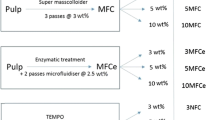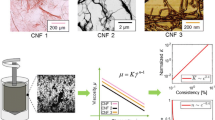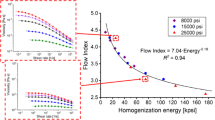Abstract
To probe the behaviour of fibrillar assemblies of ovalbumin under oscillatory shear, close to the percolation concentration, cp (7.5%), rheo-optical measurements and Fourier transform rheology were performed. Different results were found close to cp (7.3%), compared to slightly further away from cp (6.9 and 7.1%). For 6.9 and 7.1%, a decrease in complex viscosity, and a linear increase in birefringence, Δn′, with increasing strain was observed, indicating deformation and orientation of the fibril clusters. For 7.3%, a decrease in complex viscosity was followed by an increase in complex viscosity with increasing strain, which coincided with a strong increase in Δn′, dichroism, Δn″, and the intensity of the normalized third harmonic (I3/I1). This regime was followed by a second decrease in complex viscosity, where Δn′,Δn″ and I3/I1 decreased. In the first regime where the viscosity was decreasing with increasing strain, deformation and orientation of existing clusters takes place. At higher oscillatory shear, a larger deformation occurs and larger structures are formed, which is most likely aggregation of the clusters. Finally, at even higher strains, the clusters break up again. An increase in complex viscosity, Δn′, Δn″ and I3/I1 was observed when a second strain sweep was performed 30 min after the first. This indicates that the shear-induced cluster formation and break up are not completely reversible, and the initial cluster size distribution is not recovered after cessation of flow.






Similar content being viewed by others
References
Egmond JW (1998) Curr Opin Colloid Interf Sci 3:385–390
Raghavan SR, Khan SA (1997) J Colloid Interf Sci 185:57–67
Verduin H, Gans BJ, et al (1996) 12:2947–2955
Yekta A, Xu B, et al (1995) Macromolecules 28:956–966
Kishbaugh AJ, McHugh AJ (1993) Rheol Acta 32:9-24
Bergenholtz J, Wagner NJ (1996) Langmuir 12:3122–3126
Varadan P, Solomon MJ (2001) Langmuir 17:2918–2929
Marrucci G, Bhargava S, et al (1993) Macromolecules 26:6483–6488
Groisman A, Steinberg V (2001) Phys Rev Lett 86:934–937
Nemoto N, Koike A, et al (1993) Biopolymers 33:551–559
Doi E, Kitabatake N (1997) Structure and functionality of egg proteins. In: Damodaran S, Paraf A (eds) Food proteins and their applications. Marcel Dekker, New York, pp 325–340
Mine Y (1996) L J Agric Food Chem 44:2086–2090
Hagolle N, Relkin P, et al (1997) Food Hydrocolloids 11:311–317
Weijers M, Sagis LMC, et al (2002) Food Hydrocolloids 16:269–276
Veerman C, Schiffart G, et al (2003) Int J Biol Macromolecules 33:121–127
Reference deleted
Wilhelm M, Maring D et al (1998) Rheol Acta 37:399–405
Wilhelm M, Reinheimer P, et al (1999) Rheol Acta 38:349–356
Wilhelm M (2002) Macromol Mater Eng 287:83–105
Fuller GG (1995) Optical rheometry of complex fluids. Oxford University Press, New York
Stauffer D (1979) Phys Rep 54: 1–74
Stauffer D, Coniglio A, et al (1982) Gelation and critical phenomena Adv Polym Sci 44:103–158
Acknowledgments
The authors thank Manfred Wilhelm and Christopher Klein of the Max-Planck-Institut for polymer research in Mainz, for helpful discussions on FT-rheology and rheo-optics.
Author information
Authors and Affiliations
Corresponding author
Rights and permissions
About this article
Cite this article
Veerman, C., Sagis, L.M.C., Venema, P. et al. Shear-induced aggregation and break up of fibril clusters close to the percolation concentration. Rheol Acta 44, 244–249 (2005). https://doi.org/10.1007/s00397-004-0403-6
Received:
Accepted:
Published:
Issue Date:
DOI: https://doi.org/10.1007/s00397-004-0403-6




